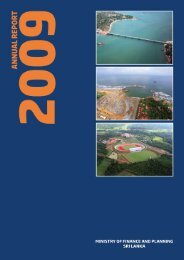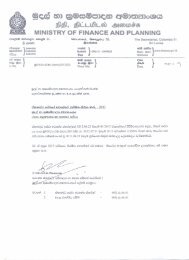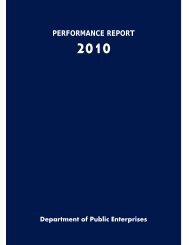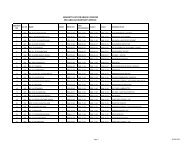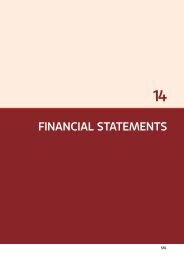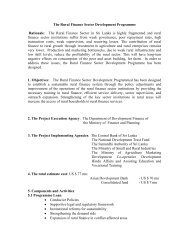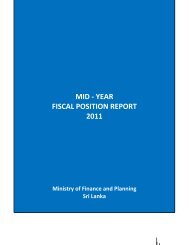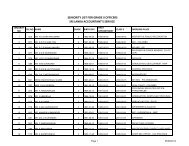Annual Report 2010 - Ministry of Finance and Planning
Annual Report 2010 - Ministry of Finance and Planning
Annual Report 2010 - Ministry of Finance and Planning
Create successful ePaper yourself
Turn your PDF publications into a flip-book with our unique Google optimized e-Paper software.
4 | State Owned Enterprises (SOE)OverviewThe SOE portfolio consists <strong>of</strong>81 state Corporations set upunder various statutes <strong>and</strong>fully government owned companiesincorporated under the Companies Actno 7 <strong>of</strong> 2007. The government is alsoa partial owner <strong>of</strong> several companiesincorporated under the Companies Act.The total turnover <strong>of</strong> SOEs at Rs. 954billion is equivalent to the recurrentexpenditure <strong>of</strong> the national budgetwhilst the total turnover <strong>of</strong> the topfive enterprises at Rs. 584.4 billionexceeds the total turnover <strong>of</strong> all the245 Companies listed in the ColomboStock Exchange at Rs. 570.3 billion 1 . Thesize <strong>of</strong> these SOEs along with the widespectrum <strong>of</strong> sectors it operates makesSOEs strategic to the development <strong>of</strong>the country.The government having established itsclear policy <strong>of</strong> non privatization <strong>of</strong> SOEsin 2005 in the Mahinda Chintana Visionfor the Future, encourages SOEs toadopt innovative management reformsso that they will become commerciallyefficient <strong>and</strong> reduce their reliance ongovernment assistance by orientingthem towards a dividend payingentrepreneurial culture.As such, in <strong>2010</strong> amongst its manyinitiatives to enhance the performance<strong>of</strong> underperforming SOEs <strong>and</strong> stateassets, the government set up the<strong>Ministry</strong> <strong>of</strong> State Resources <strong>and</strong>Enterprise Development which isresponsible for the restructuring <strong>of</strong>23 SOEs, appointed private sectorentrepreneurs <strong>and</strong> pr<strong>of</strong>essionals to theboards <strong>of</strong> strategic SOEs, strengthenedthe regulatory function <strong>of</strong> utilities(electricity, petroleum <strong>and</strong> water)through the establishment <strong>of</strong> agenciessuch as the Public Utilities Commission<strong>of</strong> Sri Lanka <strong>and</strong> consolidated themonitoring <strong>and</strong> supervisory function <strong>of</strong>the Department <strong>of</strong> Public Enterprises <strong>of</strong>the Treasury.In this regard, it is encouraging to notethat despite facing challenges bothstructural <strong>and</strong> external, the performance<strong>of</strong> SOEs in <strong>2010</strong> with entities such asCeylon Electricity Board (CEB) earningpr<strong>of</strong>its, Sri Lanka Ports Authority(SLPA) embarking on private publicpartnerships, Peoples Bank winning thePeoples award for the fifth consecutiveyear, Bank <strong>of</strong> Ceylon (BoC) <strong>and</strong> NationalSavings Bank (NSB) maintaining AA<strong>and</strong> AAA ratings respectively, etc madea positive difference to the overallperformance <strong>of</strong> SOEs.Yet many SOEs still continue to incurlosses <strong>and</strong> remain as under performingentities. While losses <strong>of</strong> Sri LankaTransport Board (SLTB) <strong>and</strong> CPCcould be mainly attributed to non costreflective pricing policies pursued dueto the government discharging its socialresponsibilities, other loss making SOEscontinued to incur losses due to lack <strong>of</strong>good governance, low productive use <strong>of</strong>employees, weak financial management,lack <strong>of</strong> internal controls <strong>and</strong> structuraldeficiencies. It is noted that Boards <strong>of</strong>management <strong>of</strong> some key SOEs, whichhave <strong>of</strong>ten made decisions that wereneither socially nor economically viable,violating the government policies <strong>and</strong>regulations contributed significantly tothe losses incurred by SOEs.As such the government channelled Rs.30,661 million or 0.5 percent <strong>of</strong> the GDPin <strong>2010</strong> to support their operationalactivities. The government has alsosupported the SOEs to finance theiroperations through the issuance <strong>of</strong>guarantees, which as at the end <strong>of</strong><strong>2010</strong> amounted to Rs. 189,412 millionaccounting for almost 90 percent<strong>of</strong> the total guarantees issued bythe government. The bulk <strong>of</strong> suchguarantees are on account <strong>of</strong> electricity,petroleum <strong>and</strong> fertilizer.Lack <strong>of</strong> good corporate practices<strong>and</strong> management lapses have resultedin compromising the SOEs ability tomanage risks that arises from bothinternal <strong>and</strong> external factors, has in turnweakened the balance sheets <strong>of</strong> SOEs.Therefore, while the government policyis to encourage SOEs to improvecorporate management, the absence <strong>of</strong>the required human capital to undertake<strong>and</strong> implement business models <strong>and</strong>boards <strong>of</strong> management that have yetnot displayed the ability to lead SOEsas dynamic enterprises remains a majorchallenge in the SOE sector.It is noted that considering themagnitude <strong>and</strong> the very nature <strong>of</strong>operations that SOEs are engaged in, ifaction is taken immediately to overcomethe aforementioned weaknesses theperformance <strong>of</strong> the SOEs could boost thegrowth momentum <strong>of</strong> the country.SOE Contributionto the NationalEconomyTotal turnover <strong>of</strong> the SOEs at Rs. 954billion, forms a significant part <strong>of</strong> the SriLankan economy constituting 17.2 percent<strong>of</strong> the GDP in <strong>2010</strong> in comparison to 16.7percent in 2009. This is in line with thegovernment’s target stipulated in the“Mahinda Chintana” <strong>of</strong> achieving a totalturnover to GDP ratio <strong>of</strong> 22 percent in2016 <strong>and</strong> further increase to 26 percentin 2020.SOEs continue to be a significantemployment generating sector with totalemployees at SOEs at almost 160,00 in<strong>2010</strong>, which constituted about 2 percent<strong>of</strong> the total labour force.In <strong>2010</strong> the government enunciated itspolicy on dividends <strong>and</strong> levies. As such,all SOEs are required to contribute 301Ceylon Electricity Board (CEB), Ceylon Petroleum Corporation (CPC), Sri Lanka Ports Authority (SLPA), Bank <strong>of</strong> Ceylon (BoC)<strong>and</strong> People’s Bank (PB)202





